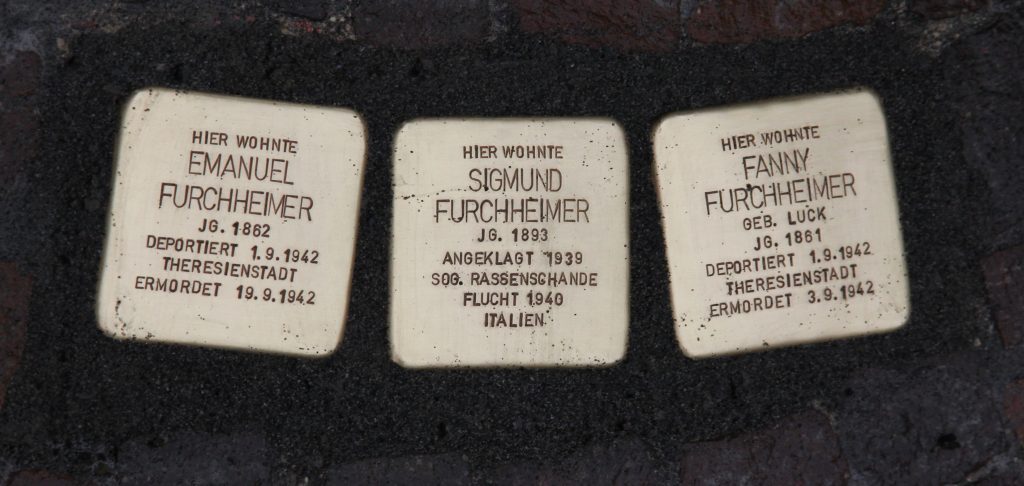
Lage: Burgstraße 22 – Bad Mergentheim
Emanuel Furchheimer and Fanny Furchheimer, née Luck married in 1890 and lived in Mergentheim since 28.2.1890. Their three children Julius (b. 5/28/1892), Sigmund (b. 9/5/1893) and Selma (b. 1/10/1897) were all born in Mergentheim.
Emanuel Furchheimer came from Hohebach and was born there on 10/31/1862. His brother Falk ran a store for cloth, clothing, manufactured goods and trousseau items in Mergentheim at Burgstraße 22, which had been founded in 1880.
His wife, Fanny Furchheimer, née Luck, was born in Messelhausen on August 11, 1861.
The family moved to Frankfurt to Gaußstraße 20 on 1.9.1939. This was certainly connected with the events of the “Reichskristallnacht” in November 1938. An angry mob of Nazis (SA and NSKK) entered the Furchheimers’ apartment, violently harassed the family, and threatened to massacre Sigmund over an accusation of racial defilement[1]. The increasing hostility towards Jews made life in a small town where everyone knew everyone else increasingly difficult. Protection was more likely to be offered by the anonymous space of a large city like Frankfurt.
On September 1, 1942, Emanuel and Fanny Furchheimer were deported in a transport from Frankfurt to the Theresienstadt ghetto. There Fanny Furchheimer died already two days later on 3.9.1942, allegedly of old age. About two weeks later, on 19.9.1942, Emanuel Furchheimer died, allegedly of intestinal catarrh and heart weakness.
Sigmund Furchheimer was also a victim of the Nazi dictatorship, but unlike his parents he was not deported and murdered. His siblings Julius and Selma had emigrated to the USA in the 1930s. His attempt to emigrate there as well failed in 1938, as did his attempt to leave for Shanghai. He was sent to prison and to the Dachau concentration camp on charges of racial defilement. In 1939, charges were brought against him in Ludwigsburg. After his release, he probably managed to escape via Austria to Yugoslavia[2]. There he was later arrested for illegal border crossing. In poor health, he was then hospitalized. After the occupation of Yugoslavia by German troops in April 1941, Sigmund Furchheimer was extradited to Italy and taken to the Italian concentration camp Ferramonte di Tarsia. (cf. list of internees dated 31.5.1943), but without extraditing him to Germany. After about a year he was released because of severe health problems and after a mental breakdown he was sent to a mental hospital. After his release, he lived in Rome, supported by Christian institutions, since he had converted in the meantime. Probably during this time he also called himself Forster, like his brother who lived in New York. However, during a police raid in December 1943, he was arrested with other Germans[3]. By order of the commander of the Sipo and the SD, he was sent with several prisoners to the Fossoli di Capri concentration camp (near Modena), but again was not extradited to Germany – the reasons are unknown. After the war, he again applied to leave the country for the USA. In a questionnaire of November 1945 he gives his brother as a reference and financial guarantor. Not much is known about his further life or his death. According to one reference, he died as Sidney Forster in the USA in 1964 [4].
- For an account of the pogrom in Bad Mergentheim: see Hartwig Behr, Zur Geschichte des Nationalsozialismus im Altkreis Mergentheim 1918-1949, Niederstetten 2020, p. 166f and Hermann Fechenbach, Die letzten Mergentheimer Juden, reprinted by the city of Mergentheim 1997, p. 160ff.
- Self-declaration of Sigmund Furchheimer in the questionnaire for emigration to the USA
- In the report on the raid at the end of 1943, his escape is described differently: he had come to Rome in 1940.
- Document 59 about the raid reports that Sigmund Furchheimer, later Sidney Forster (1893-1964), emigrated to the USA after 1945.
Laying Date: 04. April 2019
Sponsorship: none
Author: DJ 